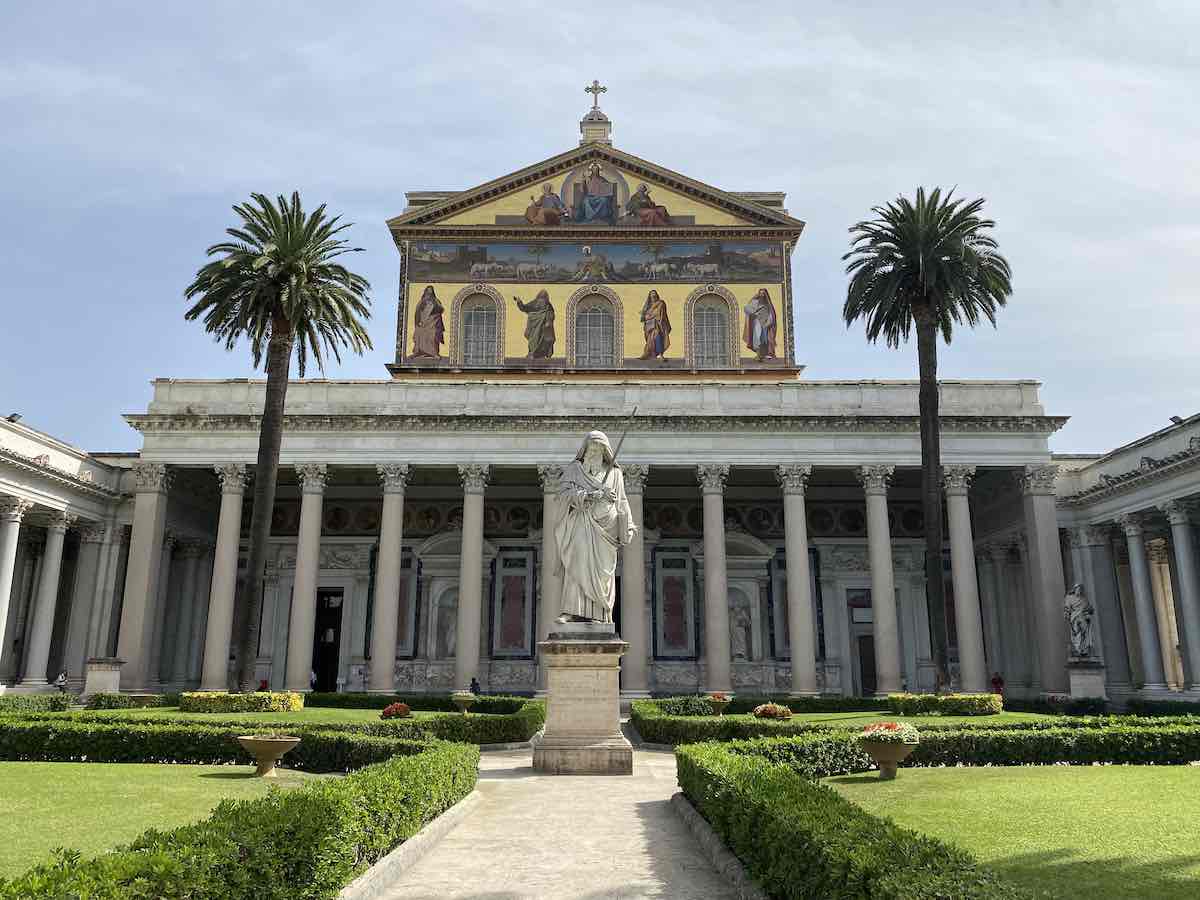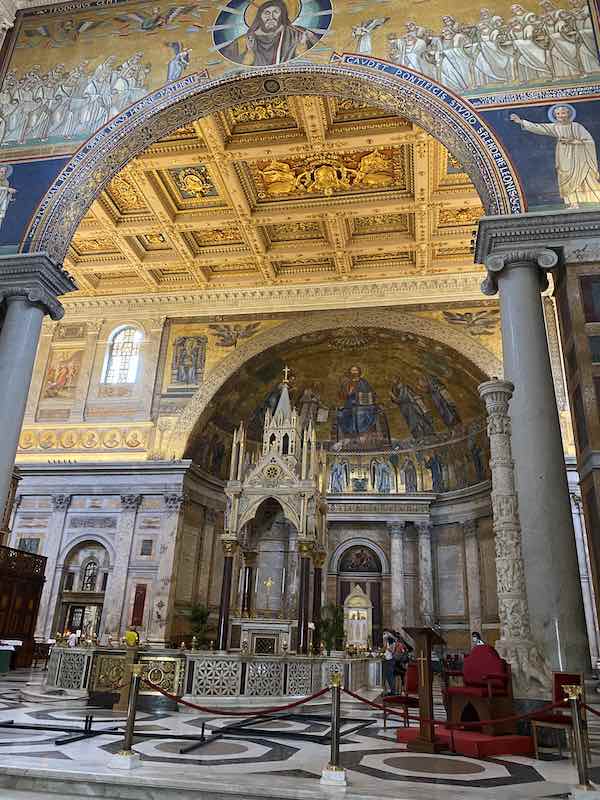Our visitors’ guide to the church of St Paul Outside the Walls (San Paolo Fuori Le Mura), one of the four major Rome’s Papal basilicas and burial place of apostle Paul.
The church of St Paul Outside the Walls (San Paolo Fuori e Mura) is one of Rome’s four major Papal basilicas.
The basilica is in the Ostiense neighborhood, just South of Rome City Center.
It is a vast, beautiful basilica, significant for religious visitors and fascinating for history and art lovers.
Due to its decentralised position, outside Romes’ most beaten track, not many non religious visitors come to visit this basilica.

Those who venture here, however, find a great reward.
Originally built on the burial place of St Paul, the basilica has a long and eventful history and has some unique and unusual corners worth seeing. .
In this guide, I share how to visit the Basilica of Saint Paul Outside the Walls, what you cannot miss there and some essential info to help you put the church in contact.
Saint Paul Outside the Wall info
Name: San Paolo Fuori le Mura
Address: Piazzale San Paolo, 1, 00146 Rome, Italy
Type: Papal Basilica (church)
Date: several reconstructions from I – IV -IX – XIX century
Opening Hours: every day 7am – 6.30 pm, except during celebrations (check times here)
Price: free for the basilica / ticketed to cloister and archaeological area (see below)
Facilities: the basilica has a cafe, toilets and a souvenir shop.
Accessibility ramps make most areas of the basilica accessible by visitors with different mobility needs.
Please note: due to the religious significance of the place, suitable attire is required. The dress code for Rome’s basilicas is the sane as the dress code for the Vatican and below the knee skirts / shorts, covered shoulders, and what the church would consider modest clothing.
Where is San Paolo Fuori Le Mura: address and how to get there
St Paul outside the walls is in the Ostiense neighborhood and it is very easy to reach from Rome city center by metro.
The exact address is: Piazzale San Paolo, 1, 00146 Rome, Italy
The closest metro stop is San Paolo, Metro line B.
The stop is only only a couple of minutes from the church and you find directions to it well indicated on leaving the station.
As you step off the train, follow the exit marked with ‘Basilica di San Paolo’ and you will see the church in front of you.
More precisely, the metro leaves you at back of the church!
As you get our of the metro, you see the church straight away, then you need to follow its perimeter to get to the main entrance, only a couple of minutes away.
Top tip: on this side of the church, you find the old monastic pharmacy: worth a stop!
The closest buses stopping at Saint Paul are 3, 766, 792
Why is St Paul’s Outside the Walls significant
St Paul’s Basilica in Rome is significant as it marks the place where apostle Paul was buried after his martyrdom in Rome.
It is also significant as it is one of the only four major papal basilicas of Rome.
The others are San Giovanni in Laterano, Santa Maria Maggiore and Saint Peter’s Basilica at the Vatican.

Papal basilicas are the highest ranking churches in the Catholic hierarchy and have special status.
As well as being place of worship for pilgrims during Jubilee years, St Pauls’ Basilica was assigned two special tasks by the Pope: the Sacrament of Reconciliation (or Penance) and the development and organization of ecumenical initiatives.
Since 2005, the basilica enjoys extraterritoriality and is managed by the Vatican through an archpriest.
St Pauls’ basilica is also significant from a historical and archaeological point of view.
As well as a church, during the course of the centuries, the basilica’s complex also acquired a benedictine Abbey and hospice for pilgrims and travelers.
A brief history of teh church of Saint Paul Outside the Walls
The first basilica of St Paul ws built in this location in 330 AD, by order of Pope Silvester.
The first basilica was raised on the the place where St Paul was buried and it symbolically faced East, as if looking towards Jerusalem.
Christianity had only become legal under Emperor Constantine the Great in 313 AD and the number of Christians in the city grew even faster then before.
This quickly borough the need for a bigger basilica.
Towadrs the end of the IV century emperor Theodosius, Valentinianus II and Arcadius built the New St Paul, much larger than the original and facing west. This new Basilica of Saint Paul was consecrated by Pope Siricius in 390 AD.
Towards the middle of the V century, an earthquake damaged the basilica.
This was significant event as it led to restoration work that gave St Pauls’ Outside the Walls a unique attribute that we still admire today: a series of portraits representing all the Popes (see below)!
Since then, many interventions shaped and changed the appearance of the basilica.
Historical sources tell us that the basilica was damaged and attacked several times and was remodelled, enlarged and rebuilt in parts several times.
The Golden Age of this basilica the Middle Ages.
This is when the church a acquires some of its most beautiful mosaics, the baldaquin, the cloister and the Paschal Candle.
In 1823 a massive fire destroyed the paleo-christian church and many of the original elements of the ancient basilica got lost.
What remained, however, was put to use and a new church was built to resemble, asm much as possible, the original one.
What to see in St Pauls’ Outside The Walls
The Basilica of sta Paul outside the walls is large indisposing.
These are the highlights we recommend yo see:
The facade and front portico
As you arrive at the front of Saint Paul’s, the first thing you notice is the age church facade with golden mosaics gleaming in the sun.
The mosaics represent the four prophets Jeremiah, Isaia, Ezechiel and Daniel, and twelve lambs (the apostles) drinking from four rivers (the gospels).
The facade is framed by a large courtyard (quadriportico) with imposing columns.
You cross it to enter the church under the watchful eyes of statue of Jesus and St Paul, that seem to welcome you into the large expanse of the main area of the church.

The central nave and the portrait of every Pope
The basilica is divided into several naves.
On top of the columns framing the central nave, there is one of the most unique things to see in Rome: a series of portraits with images of every Pope from St Peter to Pope Francis included!
The portrait are a series of round images and their collection started under Leo The Great.
After the fire of 1823, the remaining old medallions moved into the monastery, for presenrations reasons.
Not to lose such a peculiar characteristic of hte chitchatting however, Pope Gregory XVI asked for the chronological series of papal medallion be reproduced in mosaic, which are the 268 round medallions we see today.

The basilica’s mosaics
Several beautiful mosaics decorate parts of the basilica.
As well as the facade ones, worth noticing are the ancient golden mosaics on the Triumphal Arch, the large mosaics on the apse
The Papal Altar
There are several altars in this large church but only one of them is reserved to the Pope.
This is known as the Papal Altar and it can only be used for celebtations by the Pope and selected celebrants, in specific occasions.
Above this main altar stands Arnolfo di Cambio’s gothic baldaquin, one of the most exquisite examples of gothic style in Rome.

St Paul’s Grave
The Papal Altar stands on the most sacred part of hte basilica, just above the tomb of St Paul.
Sources tell si St Paul arrived in Rome in 61AD and was condemned then executed in 65AD.
Paul’s Tomb quickly started attracted faithfuls to his cella memoriae (a memorial) .
The marble tombstone marking his grave is below the Papal altar. An epigraph reads: Paulo Apostolo Mart.
It is worth notice that, while Paul was buried here, his martyrdom happened in the Abbazia delle The Fontane, another fantastic religious location of Pauline significance in Rome.
The Easter Candle
Again neat the main altar there is The Easter Candle or the Paschal Candle) a 6m tall candle with impressive carvings telling stories form the gospels, in romanesque style.
Detailed info panels give accurate description and explanations of its history to the most curious.

The Cloister And Exhibition Area
The cloister of St Paul’s basilica was dates from 1235.
Made by Cosmati and Vassalletto,it comprises one sizeable green area, surrounded by a series of columns with spiral and mosaics decor.
It is a fantastic example of medieval architecture in Rome and it is accessible from the back of the church.This area also has a pinacotheca, lapidary museum and exhibition area interesting to dig deeper into the history of this church.
The Cloister is open every day from 9:00 to 17:30, admission € 4.00 (reduced € 3.00).
St Paul’s Basilica Archaeological area
Basilica of Saint Paul archaeological area the arccaeological area is part of the basilica’s complex and lies immediately beside the church, from where you access it.
The site is an interesting archaeologic dig that now offers an insight on life in the Middle Ages.
The ancient Pharmacy
At the back of the church, the old pharmacy still stands. Nowadays, the pharmacy is a modern looking, well stocked shops and it is a great place to get digestives and herbal remedies.
What to see near St Paul Outside the Walls
If you have made your way to St Paul’s you may want to explore what else there is to see in this area.
Ostiense is a fascinating neighborhood with tons of local history. The best way to explore it is by getting a local guide.
However, you can also get a taste for it by popping into the neighnborhood market, still an authentic place for grocery shopping; I also highly recommend you see the street art of this area by taking a stroll near Via Tessalonica.
I hope you found this quick visitors’ guide to the church of St Paul Outside the Walls useful and it inspired you to visit. Safe travels to Rome!
